The machine has to be stable if it’s going to run long.
When I first started running in my early 30s, injury was the farthest thing from my mind. And it seemed that my body was fairly foolproof: in my first eight years of running, I had only one injury, a stress fracture, clearly caused by too much/too fast/too soon.
Flash forward to my 40s, however, and things just fell apart.
My long list of injuries has included IT Band Syndrome, plantar fasciitis, high hamstring tendinopathy, and Achilles tendinopathy.
I spent more time rehabbing than I did running, and this in spite of a solid, conservative approach to training.
I will probably never feel confident that my injuries are 100 percent behind me, but I do feel that I have taken the right steps to incorporate PREhab into my routine and improve my odds in the future.
Let me add here that I’m not some special snowflake—my biomechanics aren’t unusual, and I don’t have any glaring factors that have predisposed me to injury. But what I did have was a lack of good stability and strength where I needed it.
The funny thing is, I had always been faithful to strength training and what I thought was core training throughout all those years of injury. Turns out I just wasn’t doing the right things, and it took a really great PT to help me learn that and fix it.
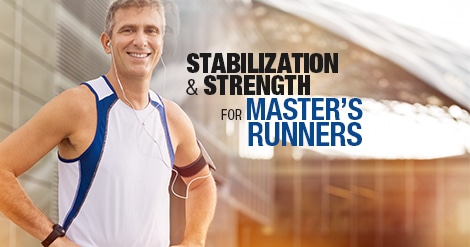
Why Master’s Runners Need Strength Work
The thing about the human body, is that muscles are really great at pinch-hitting for each other. So if your glutes aren’t firing correctly, for instance, your hamstrings might fill in. This can only last so long, however, before things start to fall apart and you end up injured.
This is especially true with master’s runners, who often have the combination of many years of improper muscle function going on coupled with years of bad habits, like sitting at desks all day long.
Today, I spend at least 30 minutes six days per week performing a variety of strength and stability exercises to help keep injuries at bay. It’s not really how I’d like to spend that half an hour, but it beats time on the injured reserve list, so I set the alarm early to fit it in, most days prior to my run.
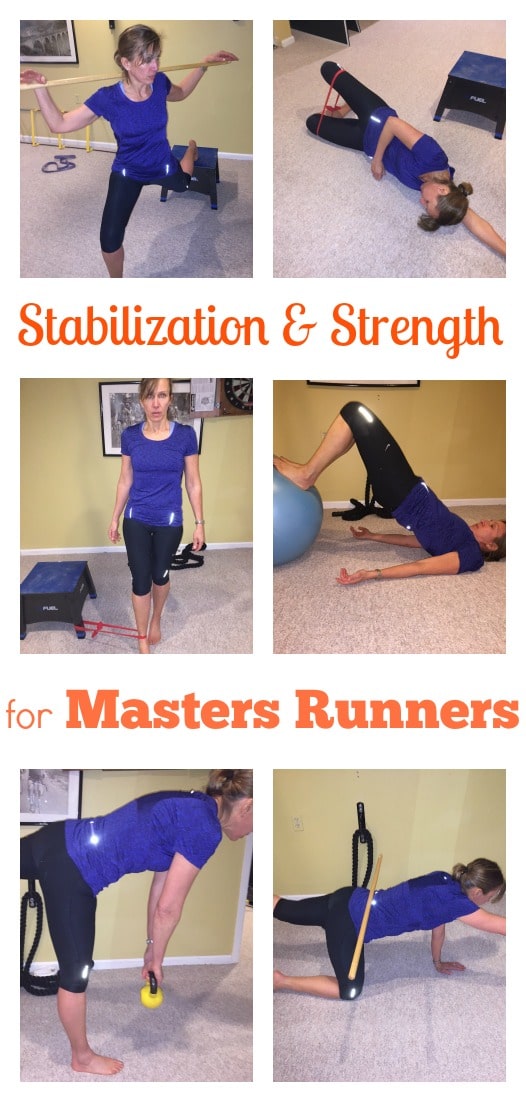 The bonus here is that I am often sufficiently warmed up when I do head out the door.
The bonus here is that I am often sufficiently warmed up when I do head out the door.
A small disclaimer: My PT recommended these exercises for my particular shortcomings, but multiple studies* have shown that by building glute and hip strength and stability, runners can decrease their likelihood for poor movement and injury.
Here then, in no particular order, are six of my go-to exercises for keeping the machine running as it should. Note that I use a large stability ball, an exercise band, a dowel, a bench, and a mirror in performing some of these moves.
I also perform all of the moves in my bare feet, so that I am better building all those stabilizing muscles—shoes provide some of this for you and can be a bit of a crutch.
When performing the exercises, I concentrate on “bracing” my core before all moves and in all of my day-to-day activities—proper bracing helps the entire kinetic chain fire as it should.
Clam shells with a band
Placing the band around your thighs, lie on the floor on one side with legs stacked and aligned. Bend both knees and open the legs at the knees, holding for five seconds at the top and then returning to the starting position. Two sets of 15 reps on each side.
Single-leg deadlifts
Probably my favorite move because I can feel my glutes activating throughout the move, plus it adds in the challenge of balance.
Facing a mirror, stand on one leg and hinge at the hips, keeping free leg straight behind. As you tilt forward with your chest, your free leg rises—this is a seesaw relationship, if you will. Move until the leg and chest are just about parallel to the ground.
Remember to keep this move smooth, slow and steady. Two sets of 15 on both sides. As this becomes easier, add in kettle bells or handheld weights.
Lunge with rotation
As much as I love the single-leg deadlift, I loathe this move! Requires a bench or plyometric box, a mirror, and a dowel.
Place one foot behind you on the box and the other in a lunge position in front. Note that you want this front leg a good distance out in front. Place a dowel on your shoulders and hold onto it with your hands. Squat down into the lunge, placing the majority of the weight on your rear leg. Rotate first to the right, back to center, and then to the left. Once back at center move up out of the lunge position—that is one rep.
Two sets of 10 reps. The key in this move is to keep your knee steady, not collapsing in or out. It’s harder than it sounds, trust me!
Bird-dog with a dowel
We are all familiar with the bird dog move, but by placing a dowel on your lower back, you will be kept honest and in the best position for running (avoiding an arched back).
Do these in front of a mirror to check form. Two sets of 15 on each side.
Stability ball bridge with curl
Lie on the ground with calves on a stability ball, and arms lying palms up so that you don’t use them in the lifting motion.
Lift your hips up off the floor so your body forms a straight line from ankles to shoulders. Then, using hamstrings and glutes, curl the ball toward your butt, bending knees. Once in this position, lift hips again into a straight line and slowly straighten legs out again, keeping hips off the ground.
That’s one rep. Two sets of 15.
Single-leg balance with band
Wrap one end of an exercise band around the ankle of one leg and the other around a secure object (I use the leg of my plyo bench). You are going to work four different directions.
First, face the bench and extend your free leg out behind you. Then stand with the bench to your side and pull your free leg across the center of your body and past your standing leg. Reverse directions so that your standing leg is closest to the bench and pull your fee leg out and away from that leg. Finally, with the bench behind you, pull your free leg up and in front of you in a running motion while moving your arms as you would in running (do with a mirror).
Switch legs. Do 20 reps in each position on each leg. Focus on keeping core stable and legs neutral.
This is just a sampling of my regular exercises—there are more where these came from! As you can see, they are time consuming but if they keep me running, they are worth every minute!
Make sure you read Amanda’s previous post, How to Master Being a Masters Runner

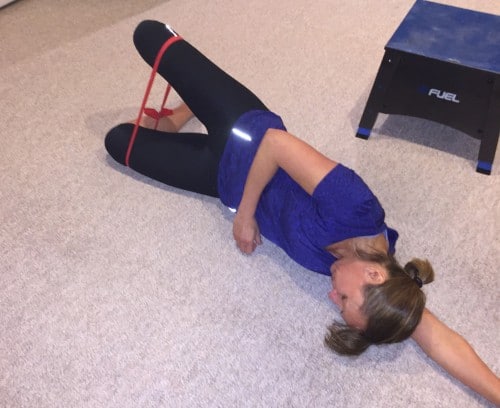

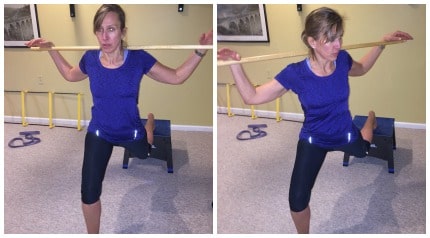
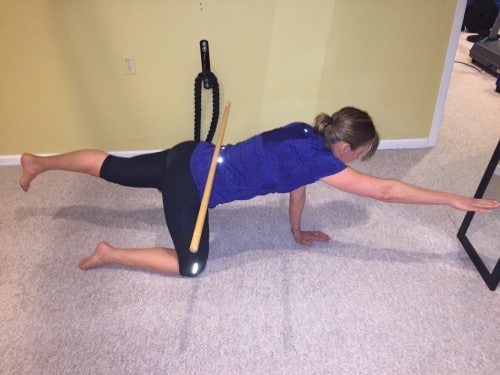
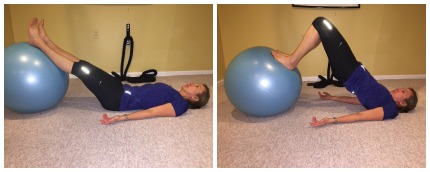
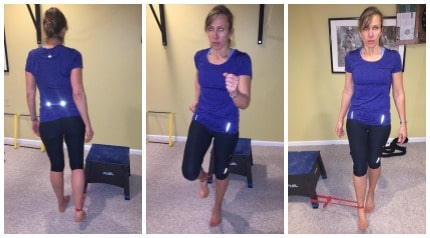




5 Responses
I’m now, at 40, officially a master’s runner! I plan to run for many years to come, and have adopted a similar preventative routine! There’s a few here that I will incorporate like the SL balance with the band and adding a dowel to my birddogs. Great stuff Amanda!
Thanks Allie, we appreciate your feedback, and wish you continued strength and speed!
Hi thanks for sharing your experices. I’m leaving you an article that i am sure will help a lot. this what PT’s want and did not know where to find it.
Mottram SL, Comerford MJ – 2008
A new perspective in risk assessment.
Physical Therapy in Sport 9,1 40-51
Thanks for sharing. Which PTs are you referring to?
the link to your blog failed…..great article